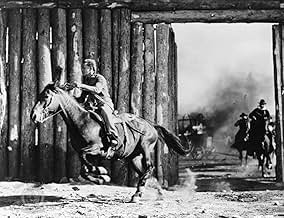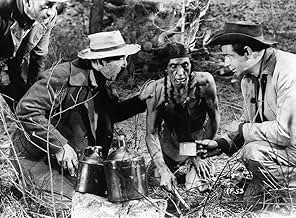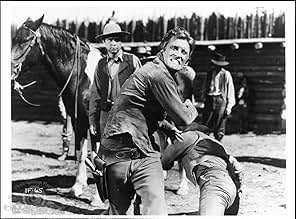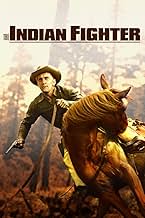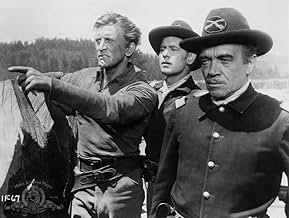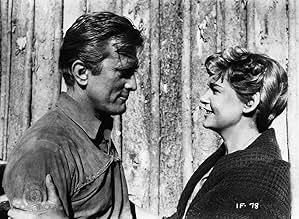AVALIAÇÃO DA IMDb
6,3/10
3,1 mil
SUA AVALIAÇÃO
Um homem conduzindo um comboio de carroças através de uma área indígena hostil, sem querer, se envolve com a filha de um chefe Sioux.Um homem conduzindo um comboio de carroças através de uma área indígena hostil, sem querer, se envolve com a filha de um chefe Sioux.Um homem conduzindo um comboio de carroças através de uma área indígena hostil, sem querer, se envolve com a filha de um chefe Sioux.
- Direção
- Roteiristas
- Artistas
Lon Chaney Jr.
- Chivington
- (as Lon Chaney)
Alan Hale Jr.
- Will Crabtree
- (as Alan Hale)
Elisha Cook Jr.
- Briggs
- (as Elisha Cook)
Lane Chandler
- Head Settler
- (não creditado)
Robert 'Buzz' Henry
- Lt. Shaeffer
- (não creditado)
- Direção
- Roteiristas
- Elenco e equipe completos
- Produção, bilheteria e muito mais no IMDbPro
Avaliações em destaque
I had noticed this video for rent several times, but had always thought that the cover photo showed Kirk Douglas with Natalie Wood. Much to my surprise, it turns out not to be Natalie at all, but someone far more unusual, Elsa Martinelli, someone it seems I know best as Charlton Heston's love interest in "The Pigeon That Took Rome", the slim but pleasant comedy from 1962.
In fact, this film is "introducing Elsa Martinelli", a fresh import from Italy at the time. Bell' Italia indeed. Elsa introduces herself to us in the opening scene by undressing completely to go for a quiet dip in the river. So it's going to be la dolce vita along the riverbank, it seems...
As the beautiful long-haired Indian maiden, Elsa finds herself teamed with Kirk, brandishing his chin and his triangular physique. The Wild West lives up to its name, not only with the Indians' fiery attack on the army fort, the film's climax, but also with the steamy roll in the "surf" by our two principals, a couple of years after "From Here to Eternity".
The film offers Elisha Cook an unusual part to play, a photographer who had worked with Matthew Brady during the War, and who now wants to immortalize the West with his camera as advertising to attract settlers. The film understands the dichotomy of preservation and destruction that his character represents.
Walter Matthau and Lon Chaney are the bad white men, while Alan Hale (Gilligan's Skipper) and Frank Cady (Green Acres' Mr. Drucker) round out a nostalgic supporting cast.
Produced by Kirk Douglas's own production company, Bryna, "The Indian Fighter" can't help but have a social conscience. It does show the strong influence of the message Western -- in its interracial romance, Cook's proto-Ansel Adams character, and so on -- but without sacrificing the adventure elements of the story.
The film boasts some spectacular Oregon scenery. It's not the Monument Valley desert landscape we're used to seeing in so many other epic Westerns when directed by John Ford, but rather mountainous and riverine terrain, more like what Ford showed us in "How the West Was Won" (1962).
André De Toth provides good solid Cinemascope direction, letting the widescreen process work its own wonders on the audience. The film however does betray more brutality than I would have expected, especially for its day.
All in all, an adventure story intelligently and attractively handled, with some depth for those who care to look.
In fact, this film is "introducing Elsa Martinelli", a fresh import from Italy at the time. Bell' Italia indeed. Elsa introduces herself to us in the opening scene by undressing completely to go for a quiet dip in the river. So it's going to be la dolce vita along the riverbank, it seems...
As the beautiful long-haired Indian maiden, Elsa finds herself teamed with Kirk, brandishing his chin and his triangular physique. The Wild West lives up to its name, not only with the Indians' fiery attack on the army fort, the film's climax, but also with the steamy roll in the "surf" by our two principals, a couple of years after "From Here to Eternity".
The film offers Elisha Cook an unusual part to play, a photographer who had worked with Matthew Brady during the War, and who now wants to immortalize the West with his camera as advertising to attract settlers. The film understands the dichotomy of preservation and destruction that his character represents.
Walter Matthau and Lon Chaney are the bad white men, while Alan Hale (Gilligan's Skipper) and Frank Cady (Green Acres' Mr. Drucker) round out a nostalgic supporting cast.
Produced by Kirk Douglas's own production company, Bryna, "The Indian Fighter" can't help but have a social conscience. It does show the strong influence of the message Western -- in its interracial romance, Cook's proto-Ansel Adams character, and so on -- but without sacrificing the adventure elements of the story.
The film boasts some spectacular Oregon scenery. It's not the Monument Valley desert landscape we're used to seeing in so many other epic Westerns when directed by John Ford, but rather mountainous and riverine terrain, more like what Ford showed us in "How the West Was Won" (1962).
André De Toth provides good solid Cinemascope direction, letting the widescreen process work its own wonders on the audience. The film however does betray more brutality than I would have expected, especially for its day.
All in all, an adventure story intelligently and attractively handled, with some depth for those who care to look.
Filmed in Oregon, Andre De Toth's film is a frontier adventure tale of the Great Sioux Nation whose heritage and culture run through the silver screen like a strong steady stream...
The motion picture touches up new ground by giving Indians a little sex appeal... Douglas, as a vigorous frontier scout, tries to attract the Indian maiden Onahti, played by the attractive brunette Elsa Martinelli... The Italian actress is seen bathing in the fresh waters of a river and later captured nude in a transparent voluminous stream...
"The Indian Fighter" concerns the efforts of a wagon train heading for Oregon in 1870... The train stops at a small frontier fort when the Sioux forbid them to pass through their territory... A seasoned scout and Indian expert, Johnny Hawks (Douglas), is assigned by the army to aid them...
Hawks rapidly goes to the camp of the dignified Chief Red Cloud (Eduard Franz) who explains that the trouble was started by white whiskey traders, trying to rob the Indians of their gold...
Hawks promises to settle th situation and the Chief agrees to appear at the fort to sign a peace treaty... However, his aggressive brother Grey Wolf (Harry Landers) repudiates peace talk because he despises all white men as dishonorable...
Douglas' portrait of Hawks is suitably vigorous and possibly comes close to depicting the actual character of such a man - Hawks is a jealous self-confident man who considers the West as his milieu... He declines to open up the West for civilization... He considers the West as 'a beautiful woman' and refuses to share her with anybody... He is a brave warrior who fights Sioux-style, and a shooter who never miss a snake... He respects the Indians as vanquished valiant enemies who deserve to be treated as human beings...
The motion picture touches up new ground by giving Indians a little sex appeal... Douglas, as a vigorous frontier scout, tries to attract the Indian maiden Onahti, played by the attractive brunette Elsa Martinelli... The Italian actress is seen bathing in the fresh waters of a river and later captured nude in a transparent voluminous stream...
"The Indian Fighter" concerns the efforts of a wagon train heading for Oregon in 1870... The train stops at a small frontier fort when the Sioux forbid them to pass through their territory... A seasoned scout and Indian expert, Johnny Hawks (Douglas), is assigned by the army to aid them...
Hawks rapidly goes to the camp of the dignified Chief Red Cloud (Eduard Franz) who explains that the trouble was started by white whiskey traders, trying to rob the Indians of their gold...
Hawks promises to settle th situation and the Chief agrees to appear at the fort to sign a peace treaty... However, his aggressive brother Grey Wolf (Harry Landers) repudiates peace talk because he despises all white men as dishonorable...
Douglas' portrait of Hawks is suitably vigorous and possibly comes close to depicting the actual character of such a man - Hawks is a jealous self-confident man who considers the West as his milieu... He declines to open up the West for civilization... He considers the West as 'a beautiful woman' and refuses to share her with anybody... He is a brave warrior who fights Sioux-style, and a shooter who never miss a snake... He respects the Indians as vanquished valiant enemies who deserve to be treated as human beings...
It's called The Indian Fighter but oddly, in Andre de Toth's post Civil War western, Kirk Douglas playing Indian scout, Johnny Hawks, is the paleface who has the closest relationship with the local Sioux tribe and its leader Red Cloud. And while there appear to be quite a few native Americans doing their bit as tribal extras, the 4 main Indian roles are taken by 3 white guys and an Italian girl. To be fair I guess, it needs to be pointed out that the film is 66 years old, when prominent Native American actors weren't exactly a dime a dozen roaming Hollywood streets.
And Hollywood streets and backlots is not where The Indian Fighter was filmed. It's setting is Oregan and the movie makes particularly good use of the ruggedly scenic locations on tap and wisely even takes some time out for some diverting philosophic conversations, about the possibilities and long - term ramifications of a shrinking frontier.
Douglas's Hawks is not even your conventional western hero. He takes on more of an anti - hero status, with much of the dramatic content occurring as a direct result of him taking his eye off the ball for long periods, whilst being distracted by the charms of Red Cloud's daughter, Ohanti. Elsa Martinelli as Onahti is almost believable in the role, if you ignore her pronounced Italian accent. Anachronistically, she is also asked to act out one of those "Stop! Stop! I love it" routines which periodically reared their heads in 20th century movie - making, where the poor old, put upon female, is asked to put aside bullying, sexist male behaviour, in demonstrating she was actually receptive to it.
The narrative, whether deliberate or otherwise, ends up quite morally correctly, in the corner of the Indians. But everything is rather awkwardly put together. This includes the 2 cheesily, funny aquatic, nude scenes; one to introduce the character of Ohanti and the second to quite ludicrously finish, the film on an almost farcical note, with Hawks and Ohanti romping in the rapids together.
The Indian Fighter will be remembered as an entertaining vehicle for a somewhat over-acting Kirk Douglas, whilst attempting to portray Native Americans in a more positive light, but through a distinctly patronising means.
And Hollywood streets and backlots is not where The Indian Fighter was filmed. It's setting is Oregan and the movie makes particularly good use of the ruggedly scenic locations on tap and wisely even takes some time out for some diverting philosophic conversations, about the possibilities and long - term ramifications of a shrinking frontier.
Douglas's Hawks is not even your conventional western hero. He takes on more of an anti - hero status, with much of the dramatic content occurring as a direct result of him taking his eye off the ball for long periods, whilst being distracted by the charms of Red Cloud's daughter, Ohanti. Elsa Martinelli as Onahti is almost believable in the role, if you ignore her pronounced Italian accent. Anachronistically, she is also asked to act out one of those "Stop! Stop! I love it" routines which periodically reared their heads in 20th century movie - making, where the poor old, put upon female, is asked to put aside bullying, sexist male behaviour, in demonstrating she was actually receptive to it.
The narrative, whether deliberate or otherwise, ends up quite morally correctly, in the corner of the Indians. But everything is rather awkwardly put together. This includes the 2 cheesily, funny aquatic, nude scenes; one to introduce the character of Ohanti and the second to quite ludicrously finish, the film on an almost farcical note, with Hawks and Ohanti romping in the rapids together.
The Indian Fighter will be remembered as an entertaining vehicle for a somewhat over-acting Kirk Douglas, whilst attempting to portray Native Americans in a more positive light, but through a distinctly patronising means.
This isn't terrible as far as a typical old western. Kirk Douglas does a great job including with his stunts. What I found rather unsettling were the several scenes where he forced himself on a woman both for kissing and sex. Rather than portray it with the disdain it should have, it's presented as a happy time which turns my stomach.
While far from perfect, it handled the Indians in a way far more credibly than most films of the day
With a title like THE Indian FIGHTER, you'd think that this was the standard "let's kill all the Indians" type movie so typical in the 1940s and 50s. However, like some of the better cowboy and Indian films of the era (such as the great FORT APACHE and the not so great CHEYENNE), the reason for the Indians hating the Whites is explained--they are not just unreasoning savages or idiots, but people justifiably angry at their mistreatment by the invading Whites. Because of this, I appreciated the film and was also happy that it also wasn't like some of the newer breed of films that paint the Indians and completely noble and the Whites as the epitome of evil! It did seem well balanced AND featured mostly Indians in Indian parts (though, oddly, they chose an Italian lady to play the female leading Indian!).
The rest of the film, while entertaining and having the usual great performance by Kirk Douglas, also is very simplistic and poorly thought out at times. For example, the motivation for why Douglas saved Walter Mathau's sorry butt at the beginning of the film is unclear. It defied common sense not to just let the Indians kill Mathau. Plus, at the end of the film, Douglas' confrontation with Douglas and Lon Chaney, Jr. was a long time coming but was resolved awfully quickly--making it seem very anti-climactic. Still, overall it does stand out from the HUGE number of look alike Westerns and it is worth your time.
The rest of the film, while entertaining and having the usual great performance by Kirk Douglas, also is very simplistic and poorly thought out at times. For example, the motivation for why Douglas saved Walter Mathau's sorry butt at the beginning of the film is unclear. It defied common sense not to just let the Indians kill Mathau. Plus, at the end of the film, Douglas' confrontation with Douglas and Lon Chaney, Jr. was a long time coming but was resolved awfully quickly--making it seem very anti-climactic. Still, overall it does stand out from the HUGE number of look alike Westerns and it is worth your time.
Você sabia?
- CuriosidadesKirk Douglas did most of his own horseback riding and, at one point, broke his nose attempting a stunt that called for him to make his horse fall. Instead of leaning back in the saddle when yanking the horse's head around to the side, Douglas leaned forward and took the full force of the horse's heavy head right in the face. Bill Williams was Douglas' stunt double, and "was an excellent rider [he was later killed doing a stunt for Nas Trilhas da Aventura (1965)], and in silhouette looked a lot like me."
- Erros de gravaçãoRight before the Indians tie Todd to the tree with the intention of burning him, he's having a conversation with Johnny. During this conversation, Johnny's left arm repeatedly changes positions, from being stretched out against the tree, to holding his hat in front of him and back to stretched out against the tree.
- Citações
Grey Wolf: There can be no friendship between Red Man and White. The fight is to the end. Ride back to your people. There is no room for you here.
Johnny Hawks: You've grown a big mouth since I saw you last, Grey Wolf, but I didn't come here to talk to a big mouth. I've come to talk to a big man.
- ConexõesReferenced in Os Eternos Desconhecidos (1958)
Principais escolhas
Faça login para avaliar e ver a lista de recomendações personalizadas
- How long is The Indian Fighter?Fornecido pela Alexa
Detalhes
Bilheteria
- Faturamento bruto nos EUA e Canadá
- US$ 2.450.000
- Tempo de duração
- 1 h 28 min(88 min)
- Proporção
- 2.35 : 1
Contribua para esta página
Sugerir uma alteração ou adicionar conteúdo ausente


